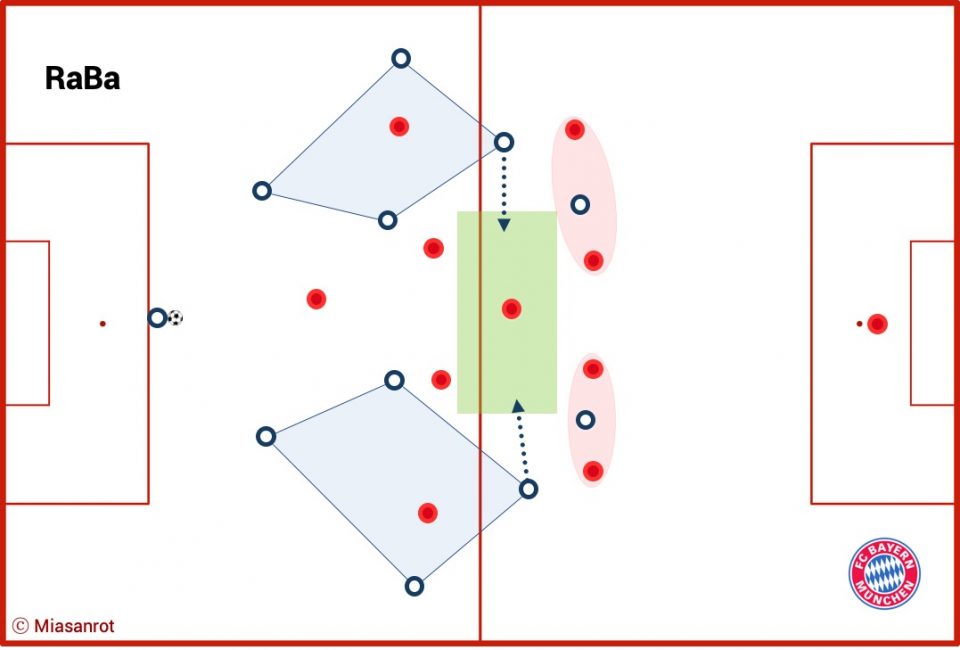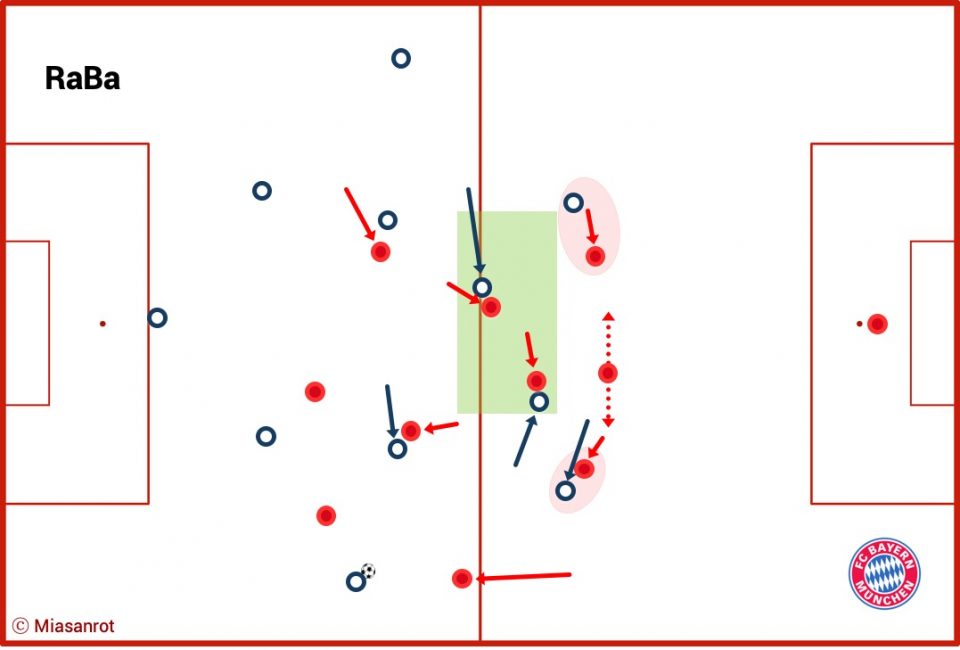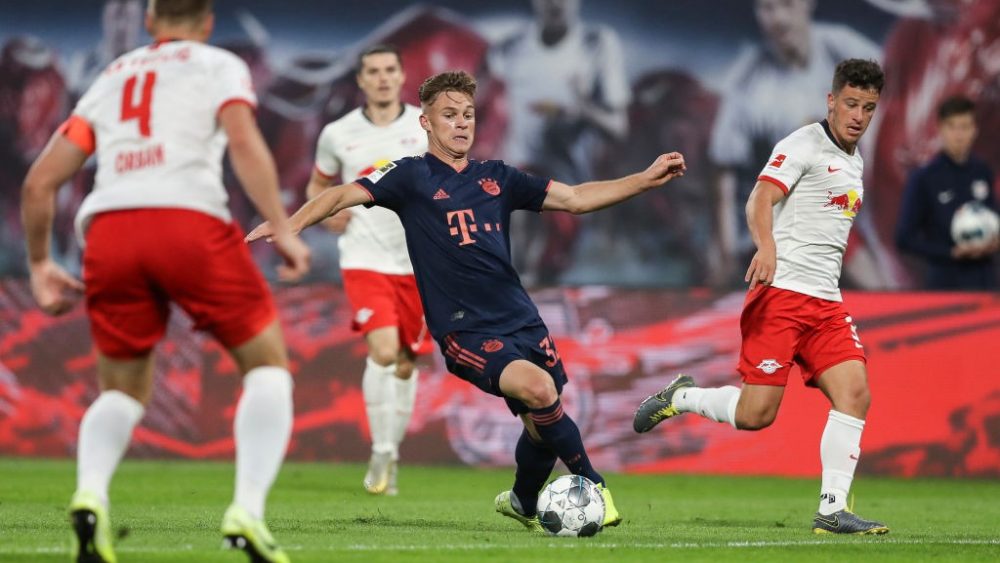Bundesliga MD 21 Preview: Bayern against Leipzig
A whiff of Jupp Heynckes and Pep Guardiola blew through the Allianz Arena on Wednesday evening as FC Bayern Munich welcomed TSG Hoffenheim in the DFB-Pokal round of sixteen. Almost right out of the gate, Bayern was off to a great start. Only three minutes had passed when Philippe Coutinho first received the ball in a dangerous area on the edge of the visitors’ penalty area. Instead of a through ball in behind, he chose to have a shot himself. Goal kick.
In the 5th minute of play, Bayern took the lead. Thomas Müller got the ball in a half-space, set up Robert Lewandowski, and the Pole comfortably converted for the 1-0 lead. But the referee called the goal back for offside. A decision hinging on millimeters. Nevertheless: A start made to measure for the record cup winners.
But then suddenly the ball was in Bayern’s goal after a loss of possession by Coutinho in his own half. 0-1. This goal stood and for the first time in a long time, Bayern had suffered a setback. Hoffenheim had come with a clever game plan: Do not push up too highly, but do not get tied up close to your own penalty area as well – and it had paid off.
But Bayern were not ruffled. Despite a well organized opponent and being a goal down, they kept playing with remarkable self-confidence and matter of factness. It followed the equalizer, the 2-1 lead, then the 3-1, all before the interval. In fact, the result at half-time should have been much clearer. But what was even more apparent: There was a clear plan. A first, almost complete display of how Hansi Flick intends his football to look. It was a demonstration of power reminiscent of the good old times.
FC Bayern against Leipzig: the contest for the center
One of the decisive elements of Hansi Flick’s football continues to be the high press, which we have already discussed in the preview of the Hoffenheim match. Let us try to illustrate more clearly why Flick’s concept of pressing is working so well at the moment in a video:
However, there are still some little issues left to address. In the first half against Hoffenheim, Bayern managed to prevent diagonal passes from the outside to the inside and were also able to quickly recover their defensive shape after a loss of possession, which made it difficult for Hoffenheim.
In the second half, however, they were not close enough to their opponents, as David Alaba admitted after the game. The possible reasons for this are yet to be finally determined. A drop of energy and focus being 4-1 up seems a plausible explanation. On the other hand, there is also the possibility that the team may not be able to sustain their intensive pace of the first half for a full 90 minutes.
Either way, it will be necessary for the team to be able to take breaks in possession in which they circulate the ball in their own ranks without giving the opponent the opportunity to counter-attack. Against Mainz this worked quite well over long phases, but against Hoffenheim this “stand-by mode” was missing and so the game finished with an unexpectedly exciting final act.
Leipzig: The little runs make the big difference
RB Leipzig is a team that immediately punishes lack of concentration and mistakes. 53 goals scored in the league alone speaks for itself. The key to Leipzig’s game is the center, which makes Bayern’s pressing quality such a decisive issue for the coming weekend. Julian Nagelsmann often tries to overload the center irrespective of the formation. Whether he chooses a 4-2-2-2, which has a certain tradition at Leipzig, a back three, or a 4-2-3-1 formation: Nagelsmann seldom fields a team with more than one designated wide player on each wing. Conversely, the center and half spaces are often tightly covered.
Drawing loosely on the motto that games are won in midfield and opponents are controlled there, Leipzig try to open up the important spaces between the lines by marking and drawing out as many opponents as possible.

The graphic shows this attempt in a 4-2-2 formation. The two full-backs are the only two wide players, while in the center the two holding midfielders bind Bayern’s two number eights. Bayern’s own holding midfielder is still free here, but Leipzig could easily create a numerical superiority by tucking in their two number eights. This would force Bayern to find a compromise: Either the full-backs follow Leipzig’s number eights inside, necessitating their wingers to track back and help out in defense. In this case the least Leipzig would have achieved is to push the opponent back.
Or a center-back pushes up and risks to leave space behind for an opposing striker to attack. Leipzig’s two strikers usually move so cleverly that they manage to keep a whole defensive line busy all on their own, making it difficult for the opponent to push a player up.
And that is exactly what Bayern’s pressing is all about. Flick and his team must be able to keep control of the center of the pitch and prevent passes into the green zone of the graphic. On the other hand, it is about not depriving yourself of your strengths, i.e. not letting yourself be forced on the defensive.
Bayern’s toolbox for the game against the ball
Finding a right balance for the two number eights could be decisive. If the ball goes to a full-back, Leipzig usually tries to find a direct path to the center with a diagonal pass. If the number eights are staggered appropriately, the overloads in the center could possibly be absorbed without an additional player.

The graphic is intended to illustrate this option: Left-back Davies moves up, being triggered by the opposing right-back’s possession of the ball. Ideally, he would even be closer to the opponent when he receives the ball than shown here. Leipzig’s right number eight can now shift into the center and draws out Bayern’s holding midfielder, which in turn opens up space for Leipzig’s left number eight.
Now Leipzig’s right striker can use the movement of his teammate and make himself available in the now vacated half-space. If one of Bayern’s defenders now were to push up to fill the vacated space left behind by Kimmich’s move, the defensive risk they would take could arguably be too high. Therefore, this should be done by a number eight.
Bayern would then act in a 4-2-3-1, but would not be deprived of their offensive power by deeper defenders or a winger dropping off. Now of course a study on a tactical board is a quite static exercise. Leipzig’s actions in possession of the ball usually take place at a very high speed. If Bayern wants to cope with their speed, they will have to be able to anticipate Leipzig’s movement patterns and the resulting consequences. It is the task of the coaching staff to prepare their team for this.
Can Bayern resist the pressure?
Of course, it is not only the quality of Bayern’s pressing that will be of great importance. Part of the reason why they were so strong against Hoffenheim in the first half was because they let their opponent do all the running. After a brief settling in period at the beginning, they got into a flow that made it almost impossible for Hoffenheim to win the ball, notwithstanding their best efforts to do so.
This was not least due to a good presence in the spaces between the lines. Corentin Tolisso has to be mentioned here, who can still improve on his passing game a fair bit, but otherwise has made some very clever movements. Coutinho in the inside-left channel also was on the move a lot, but this time only rarely impeded his teammates.
Especially his link-up play with Alphonso Davies was a clear improvement on that with Ivan Perišić in recent weeks. Coutinho’s movements opened up the space for Davies to push forward, giving the game a depth on the left side that had recently been missing. At the same time the question is warranted whether Coutinho with his sometimes poor decision-making and his borderline careless conduct in his own half (as before the 0-1 for Hoffenheim) is not too much of a risk. On the other hand, at times he was also able to provide an important creative spark to Bayern’s offensive game. The 27-year-old remains a mystery, switching between genius and madness within minutes. For the game against Leipzig, Flick could therefore opt for a less unpredictable lineup: Kimmich, Thiago and one of either Leon Goretzka and Tolisso.
While the game against the ball is all about forcing Leipzig to make mistakes, the game in possession is all about avoiding them. Leipzig will be the biggest test for how far Bayern’s build-up play has come under Flick.
What wind will blow through the Allianz Arena this time?
All the tactical details can be reduced to a few core elements. The most important aspect will be the center of the pitch. The team that gains the upper hand there will have the best chance of success. If Bayern are as awake and mentally switched on as they were against Hoffenheim in the first half, they can only beat themselves. Even against a team like Leipzig.
They in turn have the advantage of strength in depth in the squad. While Bayern’s options for in-game personnel changes are still very limited, Nagelsmann has many options available to him. For the first time in his still young career, Hansi Flick’s in-game coaching skills may be seriously put to the test during a match in the second half.
A lot will depend on how well Bayern will be able to execute their gegenpressing. Leipzig want to get into the center, Bayern want to shut it down. It is a tactical game of chess, as we so often like to say. Leipzig’s current dip in form could become a factor. But Bayern should not rely on it. Every football fan can expect a high-class contest. The question from the point of view of the record champions is: Will a whiff of Heynckes and Guardiola waft through the arena again? It would be a strong signal – especially to Bayern themselves.












I believe you do a great analysis. It is very interesting and covers every part of the game. The problem is you dont attract a large number of English speaking crowd as you post the details very late alomst 2-3 days. I also request you to post more videos in English. Thank you.
Best analysis you can get
Much better than BFW
I think Miasanrot blog is not a commercial one to begin with, hence it’s not realistic to expect the kind of 5-articles-per-day update, or on time and regular match preview-analysis. Plus, considering the level of tactical information and info, one can’t produce them in 5 minutes. I’m always grateful the Miasansrot experts dedicate there valuable free time providing there great insight and opinions, and even translating them to English so a non-German speaker like me who also do not live in Germany can follow my team in a much better way, even it’s true some match previews come just a few hours before the match start :-) I think the translation itself costs time, and in my opinion, it’s not always super fun to do.
The most similar other blog that I know is Spielverlagerung, but people there only talk about tactic, they don’t support Bayern (in the sense that a Bayern related article only appears occasionally), and they only translate to English a very few of them.
So, thank you again Miasansrot for your great works, keep them up, and never forget us English speaking community :-)